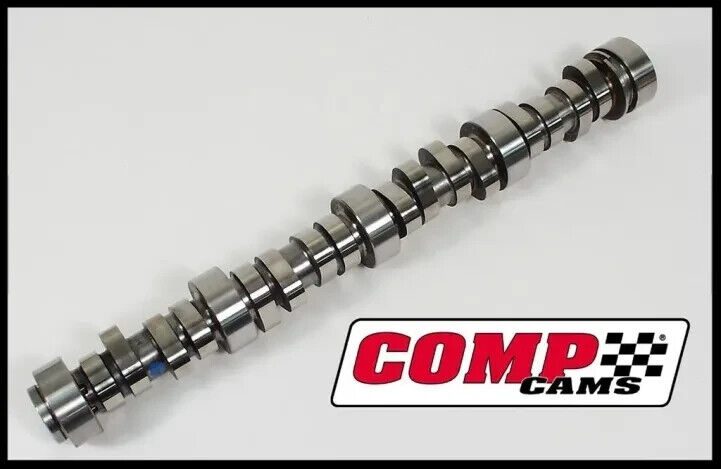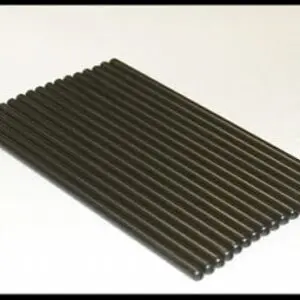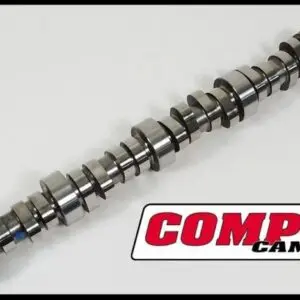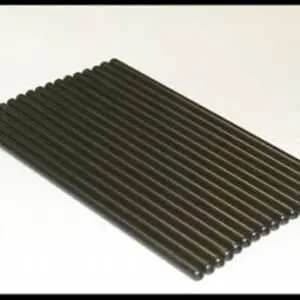Description

253/261 duration
110 lobe sep.
Comp Cams SBC Xtreme Energy Step Nose Hydraulic Roller Camshafts.
These special cams are made from an Austempered Ductile Iron Core, (a super hardened cast core), and have a reduced base circle (1.050). This allows the use of most rods on the market without having to grind any material from them when used in engines with a 3.750 stroke crank, such as those in the 383 and 406 sbc engines, and this includes the Scat H-beam rods, as they usually have the worst cam to rod interference. The 421 stroke cranks, (3.875) required very little grinding and, depending on the rod type, you may not have to grind them at all. This not only preserves the integrity of the rod, but most importantly, the rod bolt. By not having to grind the rods, you will also maintain the balance of the rotating assembly, should it have been already balanced before the rods were cam clearanced. We now use these reduced base circle cams in every sbc engine we build. These special cams can be used with a regular distributor gear. No need to run a bronze gear. Pushrod length will usually be approx. .050 longer than what a full base circle cam uses due to the reduced base of this cam.
Take a look at what has to be done to the rod body and bolt section of this rod in the picture below when using a full base circle cam in a 3.750 stroke (383 or 406) engine. The idea of having to go this far into the bolt is unsettling, to say the least. The reduced base circle cam eliminates having to do this. As mentioned above, this is one of the many reasons we now use the reduced base cams in all our sbc engines.
Important note from our company president, Skip White.
Our new line of Comp custom ground street rod cams has improved our horse power and torque numbers better than anything we have done to our lineup of street rod engines. The profiles on these cams are unique. We have increased the hp numbers approx. 20-30 with no increase in lift and duration or lobe sep. as compared to our former line of cams. As time goes, we will be adding many dyno reports with various combinations of intakes and rocker ratios, and showing this cam used in engine sizes from 383 cubic inch all the way up to our 434 pump gas street rod engines. These ads will show you many characteristics of the cam and how it will perform and our recommendations on what to expect as far as street manners are concerned.
We are often asked the rpm operating range of a given cam as stated on the cam card. This info is useless, in our opinion. These rpm ranges can be very misleading. It would be fair to say that 99.9% of people misinterpret these numbers. If we asked 20 different people just what does “operating range” mean, they would all most likely come up with a different explanation. Most people are also not aware that the size of your engine will drastically change the operating range numbers, and if you do understand that, then one must still wonder what operating range actually means.
Many cam cards will also make mention of the cam’s uses and characteristics, and we often find that info to be misleading also. The worst place to get cam recommendations is from a friend that has an engine similar to yours. Your friend often has nothing to to compare it against, and therein lies the problem. The next worst place to get a cam recommendation is from the cam manufacturer’s tech dept. We have many customers asking us to put a cam in an engine we’re building them based on the recommendations from a cam company they have spoken to. We usually find the recommendations to be terribly wrong for the customer’s application.
Our experience on a cam’s characteristics in a vehicle are based on years of feedback from our customers that have bought engines from us. This is real world experience. Our Superflo Dyno has also shown us exactly what a given cam will do in a given size engine. The compression ratio is also a very important factor in what a cam will do in an engine. For the most part, our line of engines are in the pump gas compression range.
More great info about this cam.
Carefully read the test description in each of the dyno reports below. This exact cam was chosen in many of our sbc street rod engine builds. These are all pump gas street rod engines with approx. 10.5:1 compression. Most of the 427 and 434 engines are running the 210 or 220 AFR heads on them. Various intakes and rocker ratios were used. The hp numbers produced with our new line of custom ground Comp Cams well exceed most other cams on the market the have nearly identical lift, duration and lobe sep. numbers.
Notice that we have not mentioned engine sizes below the 427 and 434, and for good reason. This cam is not recommended for these smaller engines with pump gas compression. There would be little if any power gain with this cam on a street rod over the next size down cam, but rest assured, one thing you would gain from using this cam in the smaller engines, and that would be very poor street manners, very low vacuum, and excessive valve train wear. You could use this cam in a smaller cubic inch engines with higher compression ratio of around 12:1, give or take, and gain some decent power, providing you had a set of heads with 210cc or larger runners. That kind of setup would be considered a Pro-Street rod.
The 427 and larger c.i.d. engines would not require the higher compression ratio to make this cam a decent choice. If you’re building a 427/434 street rod, then this would be the max size you could get by with on pump gas compression ratio. The 427 and 434 engines match up with this cam very nicely, and street manners become much better. 10:5.1 is about all that’s needed on these engines. The 427/434 would be considered somewhat radical on the street with this cam with fair drivability, but still much too big for very heavy cars running overdrive trans.
Be careful when selecting a cam. Most people can’t get the “bigger is better” mentality out of their head. We have at this moment four of the custom ground Comp reduced base circle cams to offer. We are thinking of adding one or two more to fill in the gaps.
Official Dyno report on our 434 engine with this cam, Super Victor 2 intake, 1.6 rockers, Pro Systems 1000 carburetor (supplied by customer) and an MSD distributor.
Listed below are a few important solutions to preventing valve train issues while having maximum performance and longevity in your engine when running large lift cams.
The solution to running a hyd. roller cam of decent size in an engine and avoiding valve float is an easy fix, thanks to the Howards Max Effort lifters and our Comp lightweight springs. The cost is only slightly more than the regular Howards (Morel) street/strip tie bar lifters, and they are undoubtedly the most stable hyd. roller lifters on the market without going to all out racing hydraulic roller lifters. The Max Efforts are also very quiet. Not sure what rpm range they can remain stable at, but we have pushed many of our sbc engines up to the 6,650 rpm range in order to establish the fall off point of a particular build. We now use these lifters with many of our cam choices. We have tried the Morel tie bar hyd. roller lifters on cams in the 550 and higher lift range in the past and found them highly unstable at around 5800 rpm. Well before audible valve float was evident, the horse power numbers were falling sharply due to valve float. Any cam that’s approaching the 550 lift or higher range should not use the Morel street/strip lifters. The Max Efforts were very stable well into the 6500 rpm range and higher.
The next big cause for valve train instability when running a cam in the upper lift and duration in an engine would be having spring pressure that is too low. Regardless of what some may say would be the correct spring pressure, we know what it should be for safe operation and good performance. The numbers are slightly high, according to some uninformed authorities, but running too low of a spring pressure will assure valve float before peak power is made.
If you have weak springs or wrong pressure ranges in your setup, then you must correct this. We offer a proper set of Comp valve springs that work perfectly with this cam. They do not require unusually long valves. We’re very satisfied with the seat to nose ratio. These springs are also much lighter in weight than previous springs we have used, and that’s a real plus when trying to stabilize the valve train on an engine running at near or above 6000 rpm. Our experience is vast on how to properly setup your valve train, due to the fact we have dynoed so many street rod engines.
Please read the complete ad before purchasing this cam.
|
|
|
|
|
|

Additional information
| Brand | COMP CAMS |
|---|---|
| Manufacturer Warranty | 1 Year |
Only logged in customers who have purchased this product may leave a review.




















Reviews
There are no reviews yet.